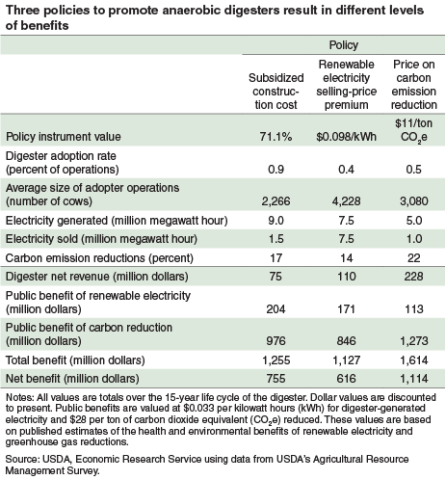Alternative Policies To Promote Anaerobic Digesters Produce Positive Net Benefits
- by Nigel Key and Stacy Sneeringer
- 12/3/2012
Anaerobic digesters capture methane from lagoon or pit manure storage facilities on farms and use it as fuel to generate electricity or heat. In addition to providing a renewable source of energy, digesters can reduce greenhouse gas (GHG) emissions. Methane is a potent greenhouse gas and burning it lessens its contribution to global warming. Rising fuel prices and the public's desire for new sources of renewable energy and reduced carbon emissions have led to government policies that support the adoption of anaerobic digesters by livestock producers. ERS research considers how the design of such policies would affect farmer adoption rates of digesters, farm incomes, and environmental benefits from use of the technology.
Policies currently in place in the U.S. that aim to make digesters more profitable for operators include (1) construction-cost subsidies (e.g., loan guarantees, accelerated depreciation, cost-share programs); (2) renewable energy standards that raise the price of digester-generated renewable electricity; and (3) carbon offset markets that pay farmers for their emissions reductions. ERS compared these three policy approaches in terms of their effect on operator net returns, digester adoption rates, electricity generation and sales, GHG emissions, and program costs. For each policy, researchers also estimated the net benefits to society from greater renewable energy production and lower GHG emissions plus the increase in producers' profits from digester adoption, net of the policy costs.
Under a scenario with a hypothetical policy budget of $500 million over a 15-year period, the construction cost-share program (providing a 71-percent subsidy) was found to induce the largest number of operations to adopt a digester and stimulate the most renewable electricity generation. The carbon pricing policy (paying $11/ton of carbon dioxide equivalents) was the most effective mechanism for reducing GHG emissions from dairy manure management, and the renewable energy subsidy (resulting in a price premium of 9.8 cents per kilowatt hour of renewable electricity) encouraged the greatest amount of electricity sales.
For all three policy approaches considered, the public benefits from lower GHG emissions and higher renewable electricity production exceed the net returns to farmers from selling electricity and carbon credits (the private benefits). In addition, for all three policies, the net benefits are positive--that is, the total private and public benefits outweigh the policy cost. While farmers might not necessarily find it profitable to adopt a digester without any government financial assistance, the study shows that public programs can stimulate digester adoption that results in substantial environmental benefits.

This article is drawn from:
- 'Carbon Emissions, Renewable Electricity and Profits: Comparing Alternative Policies to Promote Anaerobic Digesters on Dairies'. (2012). Agricultural and Resource Economics Review. Vol. 41, No. 2, pp. 139-157..

